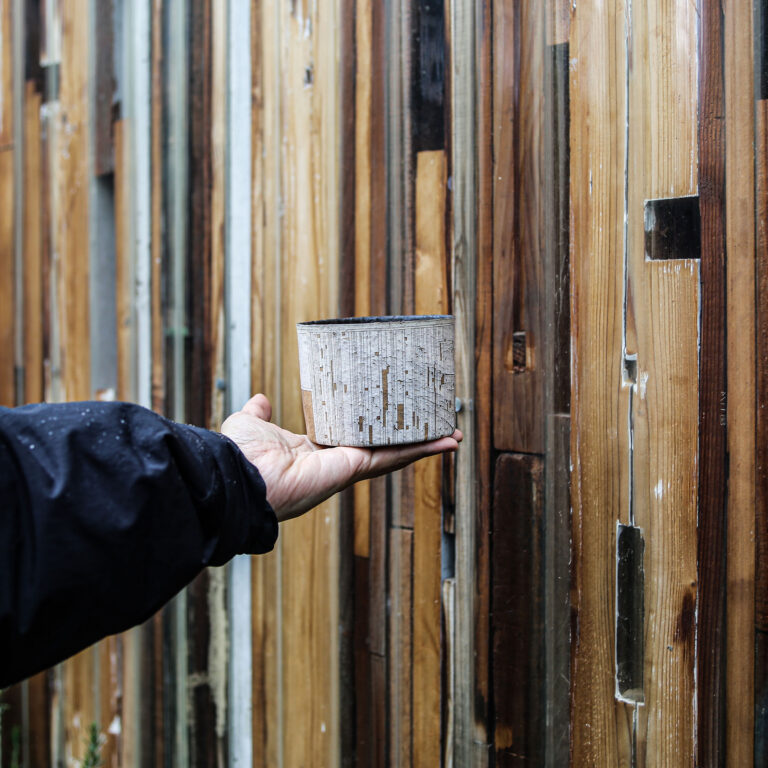
建築家の永山祐子のウェブサイトがリニューアルされています。進行中のプロジェクトや近作等の写真が閲覧可能になっています。デザインと制作は鈴木力哉 / PLANPOT DESIGN WORKSが手掛けています。
永山祐子
YUKO NAGAYAMA一級建築士
1975 東京都生まれ
1998 昭和女子大学生活科学部生活環境学科 卒業
1998 青木淳建築計画事務所 入社
2002 青木淳建築計画事務所 退社
2002 永山祐子建築設計 設立

建築家の永山祐子のウェブサイトがリニューアルされています。進行中のプロジェクトや近作等の写真が閲覧可能になっています。デザインと制作は鈴木力哉 / PLANPOT DESIGN WORKSが手掛けています。
永山祐子
YUKO NAGAYAMA一級建築士
1975 東京都生まれ
1998 昭和女子大学生活科学部生活環境学科 卒業
1998 青木淳建築計画事務所 入社
2002 青木淳建築計画事務所 退社
2002 永山祐子建築設計 設立



能作淳平建築設計事務所が設計した、東京・日本橋の、既存倉庫を改修したオフィス「101 BASE」をレポート。建て込んだ中でのカーテンウォールのデザインが事務所らしさを生み出すと共に周辺環境を内部に取り込む建築となっています。
こちらはアーキテクチャーフォトによるレポート
能作淳平が改修を手掛けた中央区の路地裏に位置する倉庫を改修したオフィス「101BASE」を訪問した。
広告に関わる企業の新しいワークスペースになるのだという。計画はこのコロナ禍の中進行された。既にクライアント企業ではテレワークでの勤務が定着しており、今まで使用していたオフィススペースの使用を取りやめ、この「101 BASE」に機能を集約することが前提で計画がすすめられた。コロナ禍以降のオフィス空間なのでである。
換気等の機能面は勿論だが、出社必要時にこのオフィスを訪問し社員の皆さんが如何に仕事に集中できるかという事が考えられている。コンパクトなフロアが3層重なった建築であり、オフィスの1階は、風通しの良い、ラウンジスペース。2階には、円形テーブルが特徴的なオフィス。3階は打ち合わせや会議などに使用できるホール空間となっている。日本橋という場所柄、1階のラウンジスペースは、将来的にカフェ等の用途としても貸し出せるようにキッチン等が配置されていたりもする。
建物の存在する環境に目を向けると、計画建物の周りにはビルが立ち並び、かなり立て込んでいることが分かる。その場所に、能作は敢えて、既存建物の壁を取り払いカーテンウォールを新設した。それはオフィスらしさをこの建物に持ち込むと共に、内部から見ると、目の前の建物の壁や配管が室内に取り込まれ、偶然が生み出した壁紙のように見える。建具枠が絵画における額縁のように機能し目の前の風景を切り取り室内に持ち込んでいる。
このような景色を取り込むことに賛否はあると思えるが、内部に佇みその景色と静かな光の変化を見ていると、そこには間違いなく豊かさや良さがある事を感じた。ビルの隙間からチラチラ見える通りを歩く人影も、フレームワークされて動く絵画の一部のように見えてしまう。
このカーテンウォールは、この固有の立て込んだ環境下で、一般的なそれとは、また違った機能や意味を持ち得ている感覚を覚えた。既存の形式を使用したとしても、それをどの環境に適応させるかで、その意味や効果が全く変わることが建築の面白いところだと思う。そしてこの場所でカーテンウォールを提案した能作のアイデアと判断は特筆すべきものだろう。勿論この建物の機能がオフィスであると言うことも前提で、これが住宅だったらまた違った感想を持ったかもしれない。
内部のデザインに目を向けると、既存の建築をよく観察し、その天高に合わせて諸機能や家具類が丁寧にデザインされていることも印象的だ。加えて、新設する部分、残す部分、の判断が丁寧である事も感じられる。それによって、新旧の対比的ではない、新しさと古さが混在したような状態でデザインがフィニッシュされ、改修だからこその心地よさが確かにある。これは、能作による自邸改修から続くものだろうとも思える。
最後になるが、法規監修には、佐久間悠の建築再構企画が関わっている。築57年の建物の改修という事で法的な裏付けを持って進められたプロジェクトであることも記載しておきたい。



長坂常 / スキーマ建築計画が設計した、韓国・済州島の、カフェ「creamm」です。長坂が「見えない開発」と呼び進めている済州島塔洞での街全体の開発プロジェクトのひとつとして完成したものです(※「見えない開発」については下部のテキストを参照)。店舗の場所はこちら。
先にも述べたが、このタプトンという土地にきてARARIOが最初に手がけたのがこのARARIOミュージアムで、大通り沿いにあり、そして背も高く、さらに赤で塗られているのでこの場所のシンボルとして遠くから見てもこの町の場所がわかる存在となっている。ただ、我々が最初にこの地に訪れた時、この街を歩く人の少なさに不安を覚えたと同時に、このMUSEUMにも人が少なくそこを改善すべく、MUSEUM CAFEとして中からのつながりを作ると主にD&DEPARTMENT側にも開き街との関係も生み出した。



ODS / 鬼木孝一郎が設計した、東京・足立区の店舗「SHIRO ルミネ北千住店」です。店舗の公式サイトはこちら。
“米粒”を連想するテクスチャーでブランドイメージを表現
自然の素材にこだわった製品を提案するコスメブランド「SHIRO」のショップデザイン。
北千住駅に直結するショピングモール内に位置し、2面が共用通路に面した人通りの多い角地となっている。人の賑わいを感じながらも、落ち着いて製品を体験できる空間を目指した。
区画の中央に大きなロの字のカウンターを配置し、共用通路側はディスプレイ、店内側はレジとタッチアップの機能をもたせた。また、店内壁面には伸びやかに連続する棚を設け、来館者を自然と店内へ引き込む平面計画とした。
カウンター及び壁面には、オリジナルで配合を調整した特殊左官材を採用。
混ぜ込んだ玉砂利の形状を浮き立たせたテクスチャーは「米粒」を連想するような奥行きのある仕上げとなっている。自然の恵みをそのまま製品に活かすSHIROのものづくりへの想いを、空間的に表現することを目指した。


吉祥寺の一軒家を改修した事務所を拠点とする「佐久間徹設計事務所」の、“気持ちよく暮らせる空間づくり”に一緒に取り組む 設計スタッフ(経験者)募集のお知らせです。詳しくは、ジョブボードの当該ページにてご確認ください。アーキテクチャーフォトジョブボードには、その他にも、色々な事務所の求人情報が掲載されています。
新規の求人の投稿はこちらからお気軽にお問い合わせください。
本当に必要なものが見直され、人の暮らす環境が重要な意味を持ち始めている現在、かたちよりも『気持ちよく暮らすこと』を大切にしたい、という考え方に共感いただいた方々からの依頼が増えてきています。
そこで、将来的な事務所の発展を見据え、設計スタッフ(経験者)を募集します。佐久間徹設計事務所は、吉祥寺に事務所を構える建築設計事務所です。
現在8名の設計スタッフ、1名の事務・広報スタッフが在籍し、国内15以上のプロジェクトが進行中です。
地元吉祥寺エリアを中心とした戸建住宅、商業建築をはじめ、都心駅近の集合住宅や高齢者向け福祉施設、郊外のリゾート建築など、幅広いタイプの建築の設計監理をしてきました。
一方で、経営戦略について所内でオープンに話し合うことで、スタッフ全員が事務所運営等についても身近に感じながら仕事を進められるようにしています。スタッフの大半は近隣から自転車で通勤しており、一軒家を改修した事務所はとても風通しのよい環境です。
新しい時代に、明るくポジティブに、一緒に楽しく建築設計に取り組んでくれる方、ご応募お待ちしております。———————————–
■業務内容・環境
当事務所の方針として、新人でも入った瞬間から、できるだけ自分の力で考えてもらうようにしています。
そのため、入社早々に1つのプロジェクトのメイン担当として、基本設計から実施設計、現場監理まで主体的に関わることができます。能力に応じて昇給・役職アップを行いながら、対応力次第でどんどん仕事を任せていきたいと考えています。
一方、事務所の体制としては、いつでも先輩からのアドバイスを受けられように数名のチーム編成を組み、さらに全てのプロジェクトについて代表の佐久間と直接打合せを行いながら進めていきます。
また、スタッフには、ジャンルが偏らないように、個人住宅に限らず店舗や集合住宅、リゾート建築など様々なタイプの案件を配置しています。構造形式を含めて、様々なプロジェクトを数多く経験できるため、独立を目指して力をつけたい方には最適な環境です。■将来的な展望への支援体制
◎独立支援
将来的に独立を志している方は、開業までのステップとして、例えば新人の場合、5年間程度で基本的なスキルを習得いただき、その後3年間ほど事務所でパフォーマンスしていただくようなプログラムを用意しています。
その際には、途中で建築士資格取得のための勉強をしながら勤務することも可能です。また、その後、独立へ向けた支援を受けることもできます。なお、期間(年数)については経験や能力に応じて、柔軟に対応させていただきます。◎事務所の中心として長く勤めたい方への支援
長く勤めていただけることは事務所にとって大きな財産ですので大歓迎です。将来、事務所の中枢として事務所を支えてくれるようなスタッフは大切に育てますし、事務所と一緒に成長していくために事務所運営についても一緒に考えていただきたいと思っています。
また、事務所に安心して長く勤めやすくなるようなシステム作り(退職金、積立金、など)についても一緒に考えていきたいと思っています。■暮らしを大切に
日々、忙しく仕事をしてはおりますが、家族のこと、自分のことを大切にしよう!という風潮もあります。
スタッフの中には小さな子どもを持つ親として、男女問わず保育園の送迎などに関わりながら勤務している者もいます。
昼は近所のお惣菜屋さんから届く美味しいおかずと、事務所で炊いたごはんで、まかないランチを食べています。



長坂常 / スキーマ建築計画が設計した、韓国・済州島の、レンタルバイク兼バイクショップ「Portable」。長坂が「見えない開発」と呼び進めている済州島塔洞での街全体の開発プロジェクトのひとつ(※「見えない開発」については下部のテキストを参照)。また、「Portable」は、先に特集記事として紹介した「FREITAG JEJU by MMMG」の1階に位置しています。店舗の場所はこちら。
そして、その一階にチェジュを訪れる観光客に楽しんでもらえるコンテンツとしてレンタルバイク兼バイクショップを計画した。さらにJEJU島の広さを考え、車と併用し、サイクリングを楽しむのが良いと考え、折り畳み自転車で統一した。そしてさらに時にヨガなどスポーツにまつわるワークショップもここで行うため、いつでもフラットに広くその場が使えるように天井の懐を自転車の収納として使える昇降式ハンガーシステムを設置した。そこには自転車だけでなく、洋服などもかけられ自由に自転車や洋服などが手に取れるようになっている。

アーキテクチャーフォトで、先週(期間:2021/5/17-5/23)注目を集めたトピックスをまとめてご紹介します。リアルタイムでの一週間の集計は、トップページの「Weekly Top Topics」よりご覧いただけます。
畑友洋建築設計事務所のウェブサイトに、大阪の住宅「奥天神の家」の写真が15枚掲載されています。
丘陵地の遺伝子
なだらかに広がる丘陵地における住宅の計画である。この地域は複雑な傾斜面を小さく分割し、入り組んだ擁壁によって取り囲まれた住宅地となっている。周辺の建物を観察すると、1つの住宅単位が単一のボリュームにまとめられるのではなく、小さな部分の集合として建ち現れているものが多いことに気付く。これは、丘陵地ならではの細かな地形の起伏による地盤の高低差や、不整形な土地の形状に合わせて、建物を小さく刻み、大地に定着してきた建ち方の現われであり、それらの集まりが、細かくずれながら密集する住戸の特徴的な風景となって現れているように思った。このような風景に現れる丘陵地の遺伝子を引き継ぎながら、新しくアイデアを加えて発芽させる方法論について考えてみた。敷地は、周囲の丘陵地の環境と同様に、法面に囲われ、周辺の地盤とのレベル差によって、建築可能な部分は限定された場所である。それは周囲の家々にもみられる特徴でもある。
そこで、地上階をコンパクトにまとめ、上階で必要な諸室を、幹から枝葉を分岐、拡張させるようなイメージで展開してみる。分岐させることによる空間の個別性と、その連なりによる多方向への拡がりを両立させることができる仕組みである。
次に、分岐した枝葉の居場所にふさわしい形を与える。それらは軒下を介して内と外が自然と繋がる小さな屋根の集まりとして、周辺の建物の小さな粒とリズムを合わせた風景となる。そうすることによって、窓の外に見える自分の家の屋根とその先の屋根屋根の風景が連続することで、大きな広がりを認識することができると考えた。
大地の起伏に小刻みに応答し、小さく分岐する空間とその繋がりそのものが住まいの佇まいとなる、丘陵地の遺伝子を持った建築の姿に結実したのではないだろうか。

403architecture [dajiba]の橋本健史が、陶芸家・松永圭太とコラボレーションする「松永圭太×橋本健史 展」が、岐阜・多治見市の、スペース大原で開催されます。会期は2021年6月5日~6月20日。入場無料。
ceramic art × architecture
陶芸家・松永圭太と建築家・橋本健史(403architecture [dajiba])のコラボレーションによる展覧会を開催いたします。
松永は学生時代に建築を学んだのち、陶芸の道に進みました。その制作プロセスにおいて常に対象を客観的に捉えようとする態度には、建築的な視点が多分に含まれています。一方橋本は、403architecture[dajiba]の一員として、既存の枠組を読み替えることで、スケールにこだわらず多様な建築的プロジェクトを手掛けてきました。今回の展示は、異なる分野で活動する同世代の両者が出会うことで、あらかじめ想像できないような化学反応を期待して企画しました。
表面的なコラボレーションに陥らないために、長い期間で対話を重ねながらさまざまな可能性を模索してきました。その結果として生まれたアウトプットは、明確な役割を分けることなく、両者の要素が複雑に入り混じったこれまでにない作品となっております。
それぞれの分野での更なる活躍が期待される二人の、垣根を飛び越えた協同作業の成果をぜひご高覧ください。
その他の作品写真等は以下でご覧ください。
丹下健三が設計した「代々木競技場(1964年竣工)」や、前川國男が設計した「木村産業研究所(1932年竣工)」が、国の重要文化財になるとのことです。リンク先にこの2件を含む7件の、新たに重要文化財となる建築の概要が掲載されています。
文化審議会(会長 佐藤 信)は、令和3年5月21日(金)に開催された同審議会文化財分科会の審議・議決を経て、7件の建造物(新規7件)を重要文化財に指定することを文部科学大臣に答申しました。
この結果、官報告示を経て、国宝・重要文化財(建造物)は、2,530件、5,253棟(うち国宝228件、291棟を含む。)となる予定です。


猿田仁視が主宰する「HITOSHI SARUTA Architect」「CUBO design architect」の、業務拡大に伴い、即戦力スタッフ・外部設計協力者募集のお知らせです。詳しくは、ジョブボードの当該ページにてご確認ください。アーキテクチャーフォトジョブボードには、その他にも、色々な事務所の求人情報が掲載されています。
新規の求人の投稿はこちらからお気軽にお問い合わせください。
CUBO design architect では、新たなる展開に対応すべく、2つのブランド態勢とし、国内外からのオファーに応えております。
業務拡大に伴い、即戦力スタッフを募集します。
パートタイムも含め募集致します。HITOSHI SARUTA Architect Website → https://www.hitoshisaruta.com/
CUBO design architect Website → https://www.cubod.com/

大阪府堺市の泉北ニュータウン茶山台団地にて、大阪府住宅供給公社主催の住戸改修実施コンペ「第7回茶山台団地リノベーションコンペ」が開催され、参加者を募集しています。応募期間は、2021年年7月7日午後5時まで。オンライン事業説明会が2021年年5月27日に、現地確認会が2021年年6月2日・3日に開催されます。【ap・ad】
大阪府住宅供給公社では、泉北ニュータウンの茶山台団地を団地再生のリーディングプロジェクト団地と位置づけ、若年夫婦や子育て世帯などの若年層を本地域に誘引するため、堺市との連携事業である「堺市と大阪府住宅供給公社による泉北ニュータウン住戸リノベーション促進連携事業」を平成27年度より実施しています。2戸の住戸を1戸につなげた「2戸1化リノベーション(ニコイチ)」や「1住戸リノベーション(リノベ45)」などの住戸改善事業では、茶山台団地におけるこれまでの取り組みに新たな活力を呼び込めるような魅力あるプランを公募します。
テーマ 「茶山台団地で____をみつける」
本事業の主旨を踏まえ、応募者ご自身で____にあたるテーマを定め、新しいライフスタイルの提案をしてください。
ザハ・ハディド・アーキテクツ、ETHZ(スイス連邦工科大学チューリッヒ校)のBRG、incremental3Dが共同研究した橋「Striatus」です。伝統的な石積みと先端技術を組み合わせて作られ、ヴェネチアビエンナーレ国際建築展2021の期間中に実物が公開されるそうです。
こちらはリリーステキストの翻訳
スイス連邦工科大学チューリッヒ校のBlock Research Group(BRG)とZaha Hadid Architects Computation and Design Group(ZHACODE)がincremental3Dと共同で行ったプロジェクトで、Holcim社の協力を得て実現したものです。
コンクリートの新しい言語を確立したStriatusは、伝統的な石積みと先端技術を組み合わせた円形のデザインです。
幾何学的な強さ
Striatusの橋は、幾何学的な強度を達成し、補強材なしで圧縮のみで立っています。計算機による設計やエンジニアリング、ロボットによる製造などの高度な技術を用いて、伝統的な建築家の技術を蘇らせています。
円形のデザイン
Striatusは、必要な場所にのみ材料を配置するように設計されており、環境への影響を大幅に低減しています。また、補強材を使用せず、バインダーを使用しない乾式工法を採用しているため、何度でも再利用することができます。
コンクリートの新しい言語
Striatusは、構造的な情報に基づき、加工を意識し、環境に配慮したデザインで、コンクリートの可能性の世界を広げます。少ない材料でより多くのものを作るために、材料は正確に配置されています。
2021年に開催されるヴェネツィア・ビエンナーレ国際建築展において、欧州文化センター(ECC)が主催する「Time Space Existence」展のために制作されました。
イタリア・ヴェネツィアのGiardini della Marinaressaで近日公開予定。





光浦高史 / DABURA.mが設計した、大分・別府市の宿泊施設「GALLERIA MIDOBARU」です。地形を思考の出発点とし地域性と固有性を持つ建築を構想して設計されました。施設の公式サイトはこちら。
今日の地方都市では「均質化」が進み、多くの場所で地域性を感じられる空間が失われつつある。歴史的温泉地である別府も例外ではなく、それを受け止めて思考することは、設計者にとって重要な課題だと感じている。設計に当たり、地質学的時間の中で生まれたこの地の独特の地形から考え始めることで、今日の新たな地域性への思考を触発する、地域と繋がる建築を実現したいと考えた。断層崖の大地から削り出されたような壁の群れを想定し、洞窟を掘り抜くように「壁の群れ」に孔を穿つことで、空間と空間、内と外が繋がっていく建築とした。
「壁の群れ」は、酸化鉄の成分で調色したコンクリートを、大分産スギ材による「まく板型枠」によって打設した。色調はボーリング時に確認した支持層や「別府石」を参照している。白華やムラ、出目地の欠けなど、打設過程で発生する「現象」を受け入れて「景色」として仕上げている。実空間に建築が造り上げられていく時の「成り立ちの時間」を可覚化することを意図した。また、家具や仕上げに使用する木材や左官材は出来るだけ近くで産出した素材を採用し、地域の職人の手によって仕上げた。地域産業の持続可能性や輸送時のCO2排出削減に寄与するとともに、できるだけ近くの素材によって空間を構成することで、この場所の固有性を表出させたいと考えた。この場所でしか成立し得ない、この場所に身体を運ばないと体験出来ない、この地の地質学的時間に繋がる建築と空間体験を生み出すことを目指した。



長坂常 / スキーマ建築計画による、韓国・済州島の、既存建物を改修したフライターグの店舗「FREITAG JEJU by MMMG」です。長坂が「見えない開発」と呼び進めている済州島塔洞での街全体の開発プロジェクトのひとつとして完成したものです(※「見えない開発」については下部のテキストを参照)。店舗の公式サイトはこちら。
この建物は元々1~2階をバーガーキングで利用されていて、大通りのある南側に向けて作られた。
ただ、「見えない開発」構想にそって、D&DEPARTMENT JEJU by ARARIOに向けて人を流し込み建物と建物間の路地にアクティビティを生み出すためにもこの1階を人が行き交うように空洞部を増やしピロティを強調した。
実際に南北の通りを歩く人通しが互いに見通しがきくように両面を窓ガラスで構成している。
そもそもトラックの幌、シートベルト、自転車のタイヤチューブ、車のエアバッグ等を再利用し作ることから一つとして同じものがないことを売りにするFREITAGとして、その哀愁あるポップな空間をコラージュすることは当然のことで、そこと室内との境界に半屋外のバーを設置しテラスを活かせるお店づくりを行った。



長坂常 / スキーマ建築計画による、韓国・済州島の、既存建物二棟を改修した宿泊・物販・飲食等の機能を持つ施設「D&DEPARTMENT JEJU by ARARIO」です。長坂が「見えない開発」と呼び進めている済州島塔洞での街全体の開発プロジェクトのひとつとして完成したものです(※「見えない開発」については下部のテキストを参照)。施設の公式サイトはこちら。
このD&DEPARTMENT JEJU by ARARIOはD&DEPARTMENTの中でも最大で、食堂、ストア、ギャラリーに新たな機能として宿泊機能を満たすd roomとあらゆる職人、アーティスト、デザイナーなどが泊りながらワークショップできるようにキッチン+ギャラリー+寝床を備えたd newsというものが入る。
d newsは今まで数時間に限定して行っていたワークショップを数日に渡り行えるように宿泊施設を併設したワークショップスペースでより深くロングライフデザインを語り合う場所となる。
また、来るアーティストにとってもただ教えに来るだけではなく、長期滞在する中で新たな材料などに巡り合い新たな創作活動のきっかけを得ることになる。そんな双方向の文化交流地点として計画した。「ホテルのようなもの」でd roomというものがあり、ストアの延長にあり、本来ホテルというものは東西に細長く中廊下を介して南北に部屋が効率よく並ぶものだが、この建物は四角に近いことから、どの部屋も窓を設け外に接しようとするとそれぞれ中に空洞が生まれ、同時にそのために作られた開口部ではないことから各部屋に歪みが生じ一つとて同じ間取りにならない。それによって、各部屋の間取りが異なり、その暗い空洞部にトップライトをとり光を入れホテルの共用部のようなストアができた。
共用部も個室も室内にある全てのモノ、例えば家具や植物、雑貨に到るまでが全て商品で宿泊することでじっくりロングライフデザインを堪能しショッピングを楽しむ場所となる。
メールマガジンでも最新の更新情報を配信中
